kandy korn jig heads
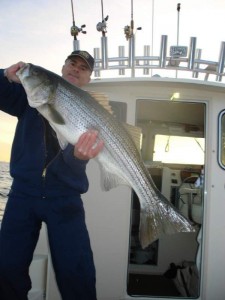 Maybe I’m getting better, but more likely I just got lucky. Either way, I called this last pattern change pretty close. As the water cools, big fish move closer to the main channel of the Chesapeake Bay. There’s still plenty of smaller fish in the rivers and the nearby flats, but since it’s late November and the season for trophies, it’s time to lock in on the channel. Here are two good reasons: Number one – water temperature. Striped bass prefer water that is warmer than 50 degrees. Surface temperatures right now in most of the Maryland section of the Chesapeake Bay are in the low 50s. Since the deeper water near the channel can be ten degrees warmer than it is in the rivers, stripers will stay closer to their comfort zone. You’ll see them holding very close to the bottom on the fish finder. They will still move up shallow to eat, but they’ll go right back to the deeper water to rest between feeding frenzies.
Maybe I’m getting better, but more likely I just got lucky. Either way, I called this last pattern change pretty close. As the water cools, big fish move closer to the main channel of the Chesapeake Bay. There’s still plenty of smaller fish in the rivers and the nearby flats, but since it’s late November and the season for trophies, it’s time to lock in on the channel. Here are two good reasons: Number one – water temperature. Striped bass prefer water that is warmer than 50 degrees. Surface temperatures right now in most of the Maryland section of the Chesapeake Bay are in the low 50s. Since the deeper water near the channel can be ten degrees warmer than it is in the rivers, stripers will stay closer to their comfort zone. You’ll see them holding very close to the bottom on the fish finder. They will still move up shallow to eat, but they’ll go right back to the deeper water to rest between feeding frenzies.
The second reason to fish near the channel is bait. Larger fish want bigger bait. The most common baitfish of any consequence in the Bay right now is menhaden. Since they migrate toward warmer water just like rockfish, by late November they are well on their way toward their comfort zones farther south. That means there is less and less bait in the upper reaches of the Bay and the biggest concentrations of menhaden are now near the channel. That’s perfect conditions for big stripers because they can hang out in the deeper warmer water and still ambush big bait. That doesn’t mean they’ll bite anything you throw at them though. Well, maybe the smaller fish will, but there’s a secret to getting the trophies. Read More!
 If the tail slaps of big rockfish can be compared to the rumble of a Chesapeake storm, I spent this past weekend riding on thunder road. We’re seeing the first signs of spring on the Bay resulting in some fun fishing. The good times this weekend were especially sweet because I just took delivery of my new Judge 27CC. If you’ve followed my website you know I’ve been looking for a new boat for some time. There are several reasons why I chose the Judge. First off, I’m used to a long boat. Having fished out of the Sea Ray for three years, I wanted something of similar length and handling so I could continue to go out in rough weather. I also needed a boat with a relatively narrow beam so I can trailer to where the fish are without worrying about permits. My other priorities included a bass boat style casting platform, a place to duck in out of the weather or sleep in emergencies, a shallow draft for fishing the near-shore top-water spots, and a long comfortable warranty. Of course price played a major role. I narrowed my decision down to three brands and Bill Judge made me the best deal even after the modifications I needed. There’s a lot to be said for cutting out the middle-man and buying directly from the boat builder, especially when it’s a local Eastern Shore guy.
If the tail slaps of big rockfish can be compared to the rumble of a Chesapeake storm, I spent this past weekend riding on thunder road. We’re seeing the first signs of spring on the Bay resulting in some fun fishing. The good times this weekend were especially sweet because I just took delivery of my new Judge 27CC. If you’ve followed my website you know I’ve been looking for a new boat for some time. There are several reasons why I chose the Judge. First off, I’m used to a long boat. Having fished out of the Sea Ray for three years, I wanted something of similar length and handling so I could continue to go out in rough weather. I also needed a boat with a relatively narrow beam so I can trailer to where the fish are without worrying about permits. My other priorities included a bass boat style casting platform, a place to duck in out of the weather or sleep in emergencies, a shallow draft for fishing the near-shore top-water spots, and a long comfortable warranty. Of course price played a major role. I narrowed my decision down to three brands and Bill Judge made me the best deal even after the modifications I needed. There’s a lot to be said for cutting out the middle-man and buying directly from the boat builder, especially when it’s a local Eastern Shore guy.
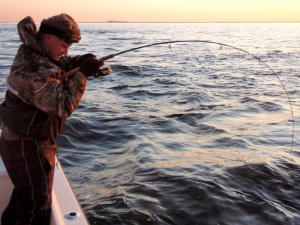 I’ve mentioned in previous reports that there are an extraordinary number of striped bass in the Bay this winter. It’s never been unusual to find a few big fish here and there during cold weather, but each year there seem to be more nice fish wintering over. I’ve managed a couple of trips this week with very good results as you can see in the photos below. Curious about why there are so many January rockfish, I put the question to Maryland Department of Natural Resources Senior Fisheries Biologist “Rockfish” Rudy Lukacovic when I ran into him at the Boatyard Bar & Grill in Annapolis one evening this week. Rudy thinks it’s all a part of changing migration patterns. He also noted that there have been fewer fish in the usual wintering grounds off the coast of the Carolinas in recent years. Read More!
I’ve mentioned in previous reports that there are an extraordinary number of striped bass in the Bay this winter. It’s never been unusual to find a few big fish here and there during cold weather, but each year there seem to be more nice fish wintering over. I’ve managed a couple of trips this week with very good results as you can see in the photos below. Curious about why there are so many January rockfish, I put the question to Maryland Department of Natural Resources Senior Fisheries Biologist “Rockfish” Rudy Lukacovic when I ran into him at the Boatyard Bar & Grill in Annapolis one evening this week. Rudy thinks it’s all a part of changing migration patterns. He also noted that there have been fewer fish in the usual wintering grounds off the coast of the Carolinas in recent years. Read More!
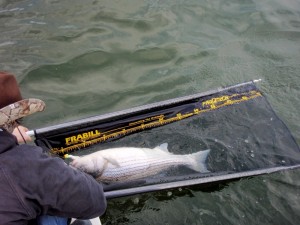 Gone are the fair-weather boaters with their blaring radios and boats bristling with broomsticks. No more planer-board trollers claiming 300 foot right-of- ways, or obnoxious broadcasters insulting everyone with a VHF radio within 50 miles. Catch & release season is the time of year when the one-man-one-rod concept reigns supreme. It’s when you can run on-plane for miles in the wide-open Bay and never see another fishing boat. A time when there’s very little competition for prime fishing spots, and a small but tight fraternity of hard-core fishermen brave the elements to jig the cold-weather hotspots. I anticipate the start of C&R season like a kid waits for Christmas.
Gone are the fair-weather boaters with their blaring radios and boats bristling with broomsticks. No more planer-board trollers claiming 300 foot right-of- ways, or obnoxious broadcasters insulting everyone with a VHF radio within 50 miles. Catch & release season is the time of year when the one-man-one-rod concept reigns supreme. It’s when you can run on-plane for miles in the wide-open Bay and never see another fishing boat. A time when there’s very little competition for prime fishing spots, and a small but tight fraternity of hard-core fishermen brave the elements to jig the cold-weather hotspots. I anticipate the start of C&R season like a kid waits for Christmas.
My sons Jacob and Daniel are visiting from Tennessee this week. We’ve been trying to work a fishing trip into our schedule, but we couldn’t get it all together until today. Read More!
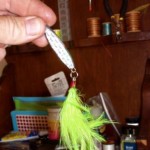 I can’t remember when I first learned to make fishing lures, but it seems like I’ve always made them. Some of my earliest childhood memories include the times my brothers and I spent with our father in his garage workshop in the hills of Tennessee. There were always lures lying around in various stages of creation. Dad melted a lot of lead and made a lot of plastic worms. I’ll never forget the terrible smell of that little shop. Sometimes the smoke was so thick from burning plastic that you could barely see a foot in front of you. I don’t know how any of us survived the noxious fumes. My dad also poured his own jigs, tied his flies, carved cedar plugs and experimented with more fishing contraptions than you can shake a jig pole at. I still have some of his creations. I usually don’t fish with them, but I keep them lying around my shop here in Maryland. They fit right in with the dozens of half-made lures I hope to finish some day.
I can’t remember when I first learned to make fishing lures, but it seems like I’ve always made them. Some of my earliest childhood memories include the times my brothers and I spent with our father in his garage workshop in the hills of Tennessee. There were always lures lying around in various stages of creation. Dad melted a lot of lead and made a lot of plastic worms. I’ll never forget the terrible smell of that little shop. Sometimes the smoke was so thick from burning plastic that you could barely see a foot in front of you. I don’t know how any of us survived the noxious fumes. My dad also poured his own jigs, tied his flies, carved cedar plugs and experimented with more fishing contraptions than you can shake a jig pole at. I still have some of his creations. I usually don’t fish with them, but I keep them lying around my shop here in Maryland. They fit right in with the dozens of half-made lures I hope to finish some day.
Read More!
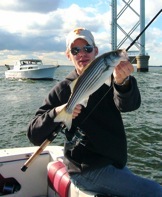 Following up the previous article on basic vertical jigging techniques, I want to share what I know for kicking it into the next gear. Most of these methods are a natural progression from vertical jigging. Jigging is an extremely productive method for catching Chesapeake Bay rockfish, so it’s something you’ll want to practice and learn well.
Following up the previous article on basic vertical jigging techniques, I want to share what I know for kicking it into the next gear. Most of these methods are a natural progression from vertical jigging. Jigging is an extremely productive method for catching Chesapeake Bay rockfish, so it’s something you’ll want to practice and learn well.
Most of my techniques have been honed over time by bass & striper fishing in fresh water situations. Bay fishing is similar in many respects, but there some special considerations.
The Chesapeake Bay is very shallow compared to many striped bass environments. While suspended fish are occasionally encountered, it’s more likely that they are either feeding on the surface or holding near the bottom. Read More!


